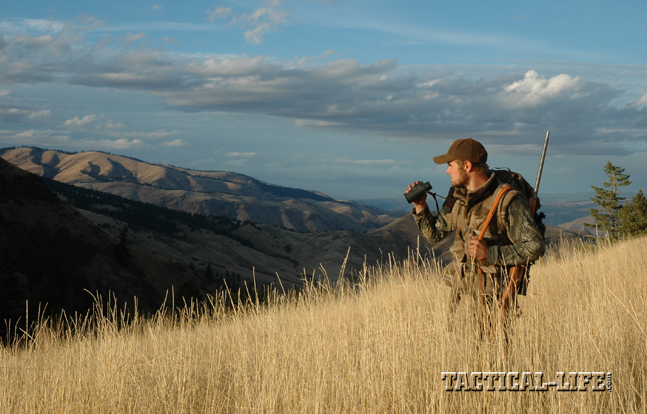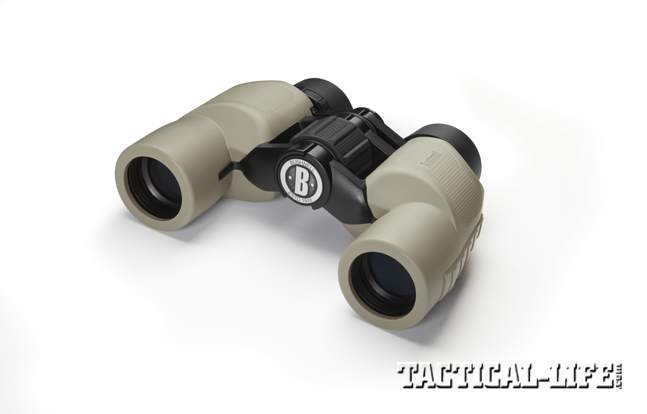Optics guru Bill McRae has looked through lots of glass. “I miss binoculars like this,” he told me once, pulling out an aged but well-kept Porro-prism. I recognized the 6×30 Bausch & Lomb right away. He saw the glint in my eye and added: “No, it’s not for sale.”
I have a couple of B&L Zephyrs of that vintage. The 9×35 would be a great glass for sheep hunting, if I could afford sheep hunting. I’ve logged many trail miles with the 7×35 on my neck. Lightweight, with no excess bulk, it rides easily. The broad, bright field finds deer and elk fast. The 5mm exit pupil is about as big as my eyes can use now, even in the darkest hunting conditions.
The past few decades have brought improved lenses and coatings, so I won’t claim my B&Ls, top-end binoculars in their day, match the best available now. Optically, they’re probably inferior to most current mid-range models—albeit lighter. (Electrician’s tape around a thin wrap of buckskin cushions the front of the 7×35’s barrels, a nearly weightless alternative to rubber armor.)
Advertisement — Continue Reading Below
Power-To-Weight Ratio
To my dismay, binoculars have taken a path away from Porro-prism (offset barrel) to roof-prism designs. And magnification has climbed. Nearly every company selling binoculars hangs its profit margin on 8×42 and 10×42 glass. They’re both useful when you’re glassing at distance, but weighing 24 to 30 ounces, they can pull your neck into a pretzel by day’s end. A harness helps, but you must struggle in and out of it to shed or don a jacket. And the elastic soon wears weak, so the binoculars bounce on your chest and drag in the sand and snow when you crawl. Most optics houses offer 32mm versions of the 8X and 10X to bring weight closer to 20 ounces. Verily, that weight advantage is well worth the small sacrifice in exit pupil.
By my reckoning, an 8X glass is better on most big-game hunts than a 10X because it can be used without support off-hand. Glassing after a stiff climb or in a frisky wind, you’ll see the small field of a 10X jump about as if in the throes of an earthquake. Better still is a 7X, with an even wider field and less sensitivity to motion. It’s a brighter glass, too, all else being equal—though until your eye starts to dilate, you won’t bump against the light-transmission limits of any hunting binoculars. In bright daylight, exit pupil size doesn’t matter because your eye’s pupil is constricted. Only at dawn and dusk, or in inky forest, will your pupil open to 5mm—the exit pupil measure of 10×50, 8×40 or 7×35 binoculars. As your eyes age, they’ll struggle to reach the 7mm traditionally given as their maximum dilation. And that would be at night.
Advertisement — Continue Reading Below
The 7X binocular, alas, gets little attention these days. A handful of 7×42 and 7×50 models exist to satisfy European hunters looking for wild pigs after dark. While some of these glasses are of very high quality, their weight and bulk make them no more appealing to me than the ubiquitous 8×42. There’s no counterpart to my trim, beloved 7×35 Zephyr.
Check Your Six
So I was astonished the other day to find, amidst binoculars powerful enough to detect plant life on Mars, four 6X models.
Yep. Six-power. Bushnell, Kowa, Meopta and Vortex catalog these useful, undersung binoculars for hunters who walk a lot and who look for game mostly inside a quarter-mile. Think about that a minute, if you would. A 6X glass makes a deer 440 yards away appear as big as a deer might be to the naked eye at 73 yards. I can still see deer at 73 steps without the help of magnification. I can still shoot deer that far away with iron sights. So why would I need more powerful glass? It seems to me, in fact, that 600 yards is well within the reach of 6X binoculars. Though more magnification will deliver more detail, you won’t need it most of the time. Granted, with a 6X you might miss the eye or antler tip that would catch your attention in the field of an 8X or a 10X. On the other hand, the six’s broader field allows you to glass more quickly and cover more country without moving the binos. And even with a compact 30mm objective, a 6X gives you 5mm of exit pupil.
Advertisement — Continue Reading Below
Here’s another reason to power down: depth of field. Lower magnification delivers a deeper look into the woods without losing focus. Very powerful glass saddles you with a shallow field. You’ll see that in a 20X riflescope. Adjustable objectives are standard on such sights to deliver tack-sharp focus across a wide range of distances. Look through a 4X scope and you’ll see the focus is quite acceptable from 50 to 450 yards. The same physical laws apply to binoculars. Moving through whitetail cover, you’re best served with 6X or 7X binoculars. If you must keep spinning that center focusing wheel to see clearly at slightly different yardage, you’ll get bored looking at the same cover, and you won’t sift surroundings as quickly or effectively as if you’d been able to see deeper into the thickets right away.
New-Breed Traits
Three of the 6X binoculars I just discovered have the Porro-prism shape and innards I prefer. The Meopta is of roof-prism design—more modern and admittedly more popular. There’s really no difference in performance, given equivalent price points. Porro bioculars are typically lighter in weight, roof-prisms more compact.
Advertisement — Continue Reading Below
The Meopta MeoPro 6.5×32 weighs 21 ounces and has a 432-foot field of view at 1,000 yards. The Vortex Raptor, another 6.5×32, weighs 17.3 ounces and has a 410-foot field of view at 1,000 yards. The Bushnell NatureView 6×30 weighs 17.3 ounces and has a 419-foot field of view at 1,000 yards. The Kowa YF30-6, also a 6×30, weighs 16.5 ounces and has a 420-foot field of view at 1,000 yards.
These are all affordable center-focus binoculars with fully multi-coated optics and features you’ll appreciate as a hunter. Because street prices of optics vary widely from MSRPs, and your preferences might differ, I can’t single out one set of binocular as a “best buy.” But all merit your attention—especially if you’re now lugging around a 27-ounce 8×42 or 10×42.
More Game
Advertisement — Continue Reading Below
What, again, about the 7X? There aren’t many to choose from. Fortunately, the market is bulging with excellent 8×32 roof-prism binoculars, some that nearly match these 6Xs for field of view. Still, save for the Big Open, I’ll pick the lower power. The deeper, less jittery field of 6X binoculars is more welcoming.
Low power gives you images much like those you’ll see with the naked eye, presumably with just enough extra “zoom” to resolve detail you’d otherwise miss. You’ll want to stay in the glass. The more time you spend there, the more game you’ll find!
In contrast, binoculars that are too strong intimidate. The limited depth and breadth of its field take your eye from the big picture outside and hold it captive. Chances are you won’t let your eye tarry in that lens because you’ll want to stay aware of what’s not there. With a 6X, you can relax. Everything you’re looking for is probably in acceptable focus right in front of your binocular!
Advertisement — Continue Reading Below
Bushnell
bushnell.com; 800-423-3537
Kowa
kowasporting.com; 800-966-5692
Meopta
meoptasportsoptics.com; 800-828-8928
Advertisement — Continue Reading Below
Vortex Optics
vortexoptics.com; 800-426-0048




























